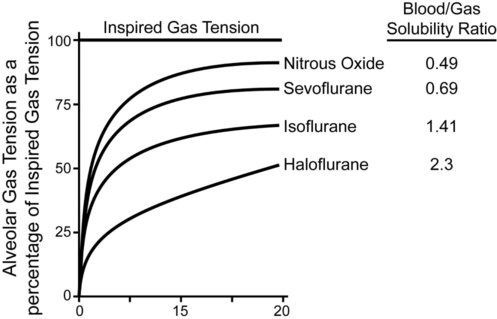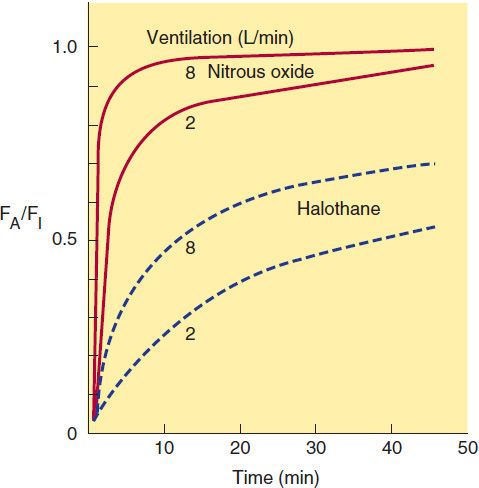The aim of inhaled anesthetics is to create a state by establishing a particular concentration of anesthetic agents in the central nervous system (CNS).
Inhalation anesthetics are one of the most common medications used for general anesthesia (GA) and only a fraction of a volatile anesthetic to the inspired oxygen results in unconsciousness and amnesia
The most commonly used volatile anesthetics are desflurane, isoflurane, sevoflurane, and these compounds clinically available in liquid form and delivered to the patient in a specialized vaporizer delivery system and fresh gas flow.
A brain concentration of an inhaled anesthetic is required for an effective anesthetic depth involves the transfer of the anesthetic from the alveolar air to the blood and from the blood to the brain.
Brain concentration is achieved primarily due to the solubility, concentration of anesthesia gas, pulmonary blood flow, ventilation, and Partial pressure in the blood.
The Solubility of Inhaled Anesthetic:
Its solubility is one of the most important factors influencing the transfer of anesthetics from the lung to the arterial blood. The solubility or blood gas coefficient of nitrous oxide is 0.49, desflurane is 0.42, sevoflurane is 0.69, and isoflurane is 1.41. The blood gas coefficient defines a relative anesthetic affinity for the blood compared to that of the inspired gas.
Nitrous oxide and desflurane has relatively less solubility in the blood therefore less molecule is required to raise its partial pressure results in rapid equilibrium with brain and faster onset of the drug.
In-reverse isoflurane and enflurane (1.80) have a higher blood-gas partition coefficient in the blood, therefore, the higher molecule is required to raise partial pressure results in slower equilibrium with the brain and slows the onset of the drug.

Anesthetic concentration in the Inspired Air:
An increase in the inspired anesthetic concentration increases the speed of anesthesia induction by raising the rate of transfer in blood. For instance,2.5% concentration of sevoflurane may be initially administered to increase the concentration in the brain, the inspired concentration is subsequently reduced to 1.5 to 2.0% when an adequate depth of anesthesia is achieved. Factors affecting inspired gas concentration includes:
- Fresh Gas flow: Increase in Fresh gas flow increase the speed of induction and increase the speed of recovery.
- The volume of the breathing circuits: More volume of circuits cause dead space and cause more dilution of gases, slower the induction.
- Absorption of the breathing circuits: Material such as rubber, silicone absorbs the anesthetic gases.
Pulmonary Ventilation:
The rate of rising of anesthetic gas tension in the arterial blood is directly dependent on minute ventilation (respiratory rate and tidal volume). Hyperventilation increases the speed of induction of Inhaled anesthetics.

Pulmonary Blood Flow:
Alteration in the blood flow to and from the lungs also influence the effect of anesthetic gases. Increase cardiac output, increases pulmonary blood flow thereby more blood is exposed to anesthetics in the alveoli. More blood is exposed to the volatile agent more effect you have.
Arteriovenous concentration Gradient
The difference in anesthetic partial pressure between alveolar and mixed venous blood depends mainly on the tissues taking up the anesthetic. If the tissue uptakes more anesthetic, the venous blood returning to the lungs has less anesthetic concentration than arterial blood. The greater this disparity in anesthetic gas tension, the longer it takes to maintain equilibrium with brain tissue.
Sources:
Katzung, B. G., Masters, S. B., & Trevor, A. J. (2009). Basic & clinical pharmacology. New York: McGraw-Hill Medical.
Inhalant Anesthesia and Inhalant Anesthetics. https://veteriankey.com/pharmacokinetics/
General Anesthetics, https://basicmedicalkey.com/general-anesthetics
